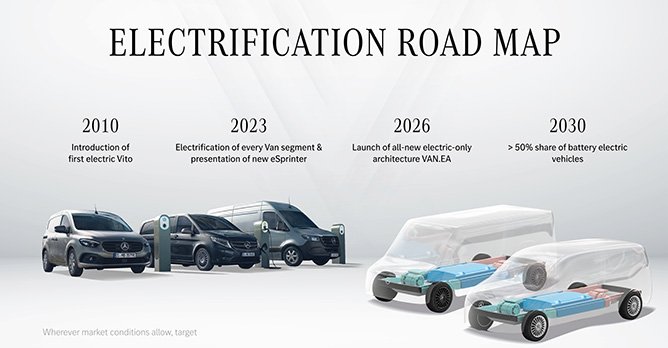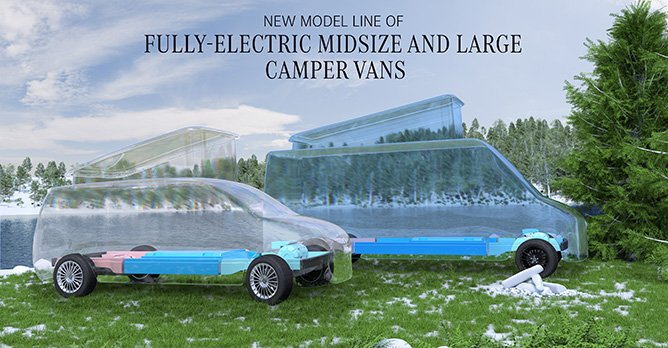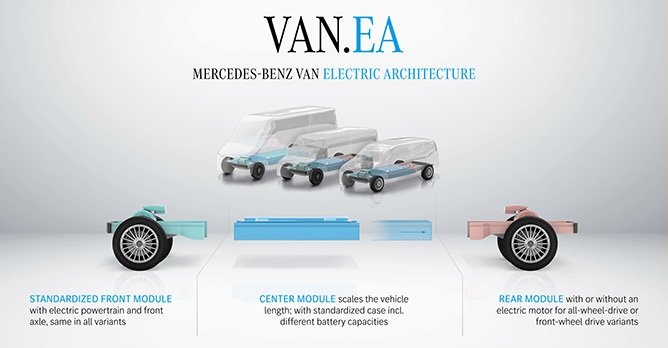Mercedes-Benz unveils new electric van platform, to be applied to all new midsize and large vans from 2026
17 May 2023|2,376 views
A new generation of vans wearing the Three-Pointed Star is on the horizon, and in line with the firm's larger e-mobility strategy, they are all set to be electric.
Mercedes-Benz has unveiled a new modular architecture set to underpin all mid-sized to large vans in the future (look to the V-Class and Vito as existing reference points), starting from 2026. Its name, 'VAN.EA', stands for 'Van Electric Architecture', and was built from the ground up to serve battery-electric vehicles (BEVs).
The move is in line with Merc's accelerating shift away from combustion engines, and comes even as the German marque reaffirmed its goal for EVs to comprise more than half of all its new vehicle sales by 2030. It is targeting an EV share of up to 20% by 2026.
Like other dedicated EV platforms, the tri-module VAN.EA will allow for vehicles to be either powered by either a single motor (for front-wheel drive variants) or dual motors (for all-wheel drive variants).
The front module, which consists of the front axle and standard electric powertrain, will be the only one kept constant beneath all the vehicles. The second, centre module will hold the vehicle's battery case, and control scalability of the vehicle's length. Finally, the rear module will be available either with or without the second electric motor.
As is already the case, the VAN.EA platform will also be applied to two main groups of vans that already exist in Merc's arsenal.
Luxury private vans make up the first half, and have been designated 'VAN.EA-P' by the firm.
Merc says the new platform will help to realise "a new level of luxury" for customers who use such vehicles a private VIP shuttles, as well as those with families who lead "leisure-active" lifestyles. Level 2 automated driving (meaning features such as lane keeping assistance and adaptive cruise control) will be available from launch.
The other half comprises premium commercial vans, underpinned by the VAN.EA-C. Payload and cargo space will be prioritised in this application. Furthermore, given the platform's modularity, a wide variety of configurations will apparently be possible - think not just e-delivery vans, but also ambulances, and even recreational vehicles (RVs) and campervans.

 Merc is hoping for BEVs to make up more than half of new vehicle sales by 2030, and the electric vans will form an important part of that roadmap Additionally, vans built atop both platforms will utilise the Mercedes-Benz Operating System (MB.OS). It's currently still unclear what sorts of new features the OS will bring with it, but an interesting highlight from Merc is its "always-on" quality - so it's not unreasonable to expect some level of machine learning.
Merc is hoping for BEVs to make up more than half of new vehicle sales by 2030, and the electric vans will form an important part of that roadmap Additionally, vans built atop both platforms will utilise the Mercedes-Benz Operating System (MB.OS). It's currently still unclear what sorts of new features the OS will bring with it, but an interesting highlight from Merc is its "always-on" quality - so it's not unreasonable to expect some level of machine learning.
As for range, Merc is confident that VAN.EA-based vehicles will be capable of more than 500km on a single charge.
Merc is aiming to broaden the reach of this particular subset of models with the new platform while reducing production complexity, by consolidating all mid-sized and larger vans within VAN.EA. A renewed push into China and the U.S.A - which has thus far never gotten private-use luxury vans from the firm - is being targeted when the new lineup is properly launched in 2026.
Mercedes-Benz has unveiled a new modular architecture set to underpin all mid-sized to large vans in the future (look to the V-Class and Vito as existing reference points), starting from 2026. Its name, 'VAN.EA', stands for 'Van Electric Architecture', and was built from the ground up to serve battery-electric vehicles (BEVs).
The move is in line with Merc's accelerating shift away from combustion engines, and comes even as the German marque reaffirmed its goal for EVs to comprise more than half of all its new vehicle sales by 2030. It is targeting an EV share of up to 20% by 2026.
Like other dedicated EV platforms, the tri-module VAN.EA will allow for vehicles to be either powered by either a single motor (for front-wheel drive variants) or dual motors (for all-wheel drive variants).
The front module, which consists of the front axle and standard electric powertrain, will be the only one kept constant beneath all the vehicles. The second, centre module will hold the vehicle's battery case, and control scalability of the vehicle's length. Finally, the rear module will be available either with or without the second electric motor.
As is already the case, the VAN.EA platform will also be applied to two main groups of vans that already exist in Merc's arsenal.
Luxury private vans make up the first half, and have been designated 'VAN.EA-P' by the firm.
Merc says the new platform will help to realise "a new level of luxury" for customers who use such vehicles a private VIP shuttles, as well as those with families who lead "leisure-active" lifestyles. Level 2 automated driving (meaning features such as lane keeping assistance and adaptive cruise control) will be available from launch.
The other half comprises premium commercial vans, underpinned by the VAN.EA-C. Payload and cargo space will be prioritised in this application. Furthermore, given the platform's modularity, a wide variety of configurations will apparently be possible - think not just e-delivery vans, but also ambulances, and even recreational vehicles (RVs) and campervans.

As for range, Merc is confident that VAN.EA-based vehicles will be capable of more than 500km on a single charge.
Merc is aiming to broaden the reach of this particular subset of models with the new platform while reducing production complexity, by consolidating all mid-sized and larger vans within VAN.EA. A renewed push into China and the U.S.A - which has thus far never gotten private-use luxury vans from the firm - is being targeted when the new lineup is properly launched in 2026.
A new generation of vans wearing the Three-Pointed Star is on the horizon, and in line with the firm's larger e-mobility strategy, they are all set to be electric.
Mercedes-Benz has unveiled a new modular architecture set to underpin all mid-sized to large vans in the future (look to the V-Class and Vito as existing reference points), starting from 2026. Its name, 'VAN.EA', stands for 'Van Electric Architecture', and was built from the ground up to serve battery-electric vehicles (BEVs).
The move is in line with Merc's accelerating shift away from combustion engines, and comes even as the German marque reaffirmed its goal for EVs to comprise more than half of all its new vehicle sales by 2030. It is targeting an EV share of up to 20% by 2026.
Like other dedicated EV platforms, the tri-module VAN.EA will allow for vehicles to be either powered by either a single motor (for front-wheel drive variants) or dual motors (for all-wheel drive variants).
The front module, which consists of the front axle and standard electric powertrain, will be the only one kept constant beneath all the vehicles. The second, centre module will hold the vehicle's battery case, and control scalability of the vehicle's length. Finally, the rear module will be available either with or without the second electric motor.
As is already the case, the VAN.EA platform will also be applied to two main groups of vans that already exist in Merc's arsenal.
Luxury private vans make up the first half, and have been designated 'VAN.EA-P' by the firm.
Merc says the new platform will help to realise "a new level of luxury" for customers who use such vehicles a private VIP shuttles, as well as those with families who lead "leisure-active" lifestyles. Level 2 automated driving (meaning features such as lane keeping assistance and adaptive cruise control) will be available from launch.
The other half comprises premium commercial vans, underpinned by the VAN.EA-C. Payload and cargo space will be prioritised in this application. Furthermore, given the platform's modularity, a wide variety of configurations will apparently be possible - think not just e-delivery vans, but also ambulances, and even recreational vehicles (RVs) and campervans.

 Merc is hoping for BEVs to make up more than half of new vehicle sales by 2030, and the electric vans will form an important part of that roadmap Additionally, vans built atop both platforms will utilise the Mercedes-Benz Operating System (MB.OS). It's currently still unclear what sorts of new features the OS will bring with it, but an interesting highlight from Merc is its "always-on" quality - so it's not unreasonable to expect some level of machine learning.
Merc is hoping for BEVs to make up more than half of new vehicle sales by 2030, and the electric vans will form an important part of that roadmap Additionally, vans built atop both platforms will utilise the Mercedes-Benz Operating System (MB.OS). It's currently still unclear what sorts of new features the OS will bring with it, but an interesting highlight from Merc is its "always-on" quality - so it's not unreasonable to expect some level of machine learning.
As for range, Merc is confident that VAN.EA-based vehicles will be capable of more than 500km on a single charge.
Merc is aiming to broaden the reach of this particular subset of models with the new platform while reducing production complexity, by consolidating all mid-sized and larger vans within VAN.EA. A renewed push into China and the U.S.A - which has thus far never gotten private-use luxury vans from the firm - is being targeted when the new lineup is properly launched in 2026.
Mercedes-Benz has unveiled a new modular architecture set to underpin all mid-sized to large vans in the future (look to the V-Class and Vito as existing reference points), starting from 2026. Its name, 'VAN.EA', stands for 'Van Electric Architecture', and was built from the ground up to serve battery-electric vehicles (BEVs).
The move is in line with Merc's accelerating shift away from combustion engines, and comes even as the German marque reaffirmed its goal for EVs to comprise more than half of all its new vehicle sales by 2030. It is targeting an EV share of up to 20% by 2026.
Like other dedicated EV platforms, the tri-module VAN.EA will allow for vehicles to be either powered by either a single motor (for front-wheel drive variants) or dual motors (for all-wheel drive variants).
The front module, which consists of the front axle and standard electric powertrain, will be the only one kept constant beneath all the vehicles. The second, centre module will hold the vehicle's battery case, and control scalability of the vehicle's length. Finally, the rear module will be available either with or without the second electric motor.
As is already the case, the VAN.EA platform will also be applied to two main groups of vans that already exist in Merc's arsenal.
Luxury private vans make up the first half, and have been designated 'VAN.EA-P' by the firm.
Merc says the new platform will help to realise "a new level of luxury" for customers who use such vehicles a private VIP shuttles, as well as those with families who lead "leisure-active" lifestyles. Level 2 automated driving (meaning features such as lane keeping assistance and adaptive cruise control) will be available from launch.
The other half comprises premium commercial vans, underpinned by the VAN.EA-C. Payload and cargo space will be prioritised in this application. Furthermore, given the platform's modularity, a wide variety of configurations will apparently be possible - think not just e-delivery vans, but also ambulances, and even recreational vehicles (RVs) and campervans.

As for range, Merc is confident that VAN.EA-based vehicles will be capable of more than 500km on a single charge.
Merc is aiming to broaden the reach of this particular subset of models with the new platform while reducing production complexity, by consolidating all mid-sized and larger vans within VAN.EA. A renewed push into China and the U.S.A - which has thus far never gotten private-use luxury vans from the firm - is being targeted when the new lineup is properly launched in 2026.
Latest COE Prices
August 2025 | 2nd BIDDING
NEXT TENDER: 03 Sep 2025
CAT A$104,524
CAT B$124,400
CAT C$72,190
CAT E$125,001
View Full Results Thank You For Your Subscription.























